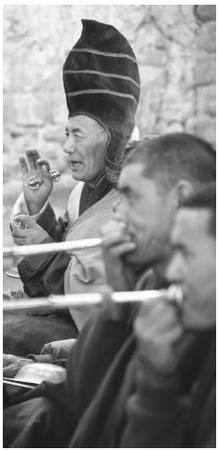Marriage, Family, and Kinship
Marriage. Nepal is overwhelmingly patrilineal and patrilocal. Arranged marriages are the norm in the mainstream culture. Because marriages forge important social bonds between families, when a child reaches marriageable age, the family elders are responsible for finding a suitable mate of the appropriate caste, education level, and social stratum.

For Buddhist monks, Nepal is significant as the birthplace of Lord Buddha.
Hindu castes do not generally approve of cross-cousin marriage, which is preferred among some Mongolian ethnic groups. Among some groups, a brideprice substitutes for a dowry. In others, clan exogamy is an important feature of marriages. Until recently, polygyny was legal and relatively common. Now it is illegal and found only in the older generation and in remote areas. Child marriages were considered especially auspicious, and while they continue to be practiced in rural areas, they are now prohibited by law. Love marriage is gaining in popularity in the cities, where romantic films and music inform popular sentiment and the economy offers younger people economic independence from the extended family.
Domestic Unit. Among landholding Hindu castes, a high value is placed on joint family arrangements in which the sons of a household, along with their parents, wives, and children, live together, sharing resources and expenses. Within the household, the old have authority over the young, and men over women. Typically, new daughters-in-law occupy the lowest position. Until a new bride has produced children, she is subject to the hardest work and often the harshest criticism in her husband's household. Older women, often wield a great deal of influence within the household.
The emphasis in joint families is on filial loyalty and agnatic solidarity over individualism. In urban areas, an increasing number of couples are opting for nuclear family arrangements.
Inheritance. Fathers are legally obligated to leave equal portions of land to each son. Daughters do not inherit paternal property unless they remain unmarried past age thirty-five. Although ideally sons manage their father's land together as part of a joint family, familial land tends to be divided, with holdings diminishing in every generation.
Kin Groups. Patrilineal kin groups form the nucleus of households, function as corporate units, and determine inheritance patterns. A man belongs permanently to the kinship group of his father, while a woman changes membership from her natal kin group to the kin group of her husband at the time of marriage. Because family connections are critical in providing access to political influence and economic opportunities, marriage alliances are planned carefully to expand kinship networks and strengthen social ties. Although women join the husband's household, they maintain emotional ties and contact with their families. If a woman is mistreated in her husband's household, she may escape to her father's house or receive support from her male kin. Consequently, women often prefer to marry men from the same villages.
No comments:
Post a Comment